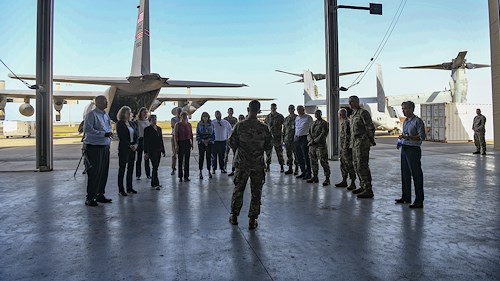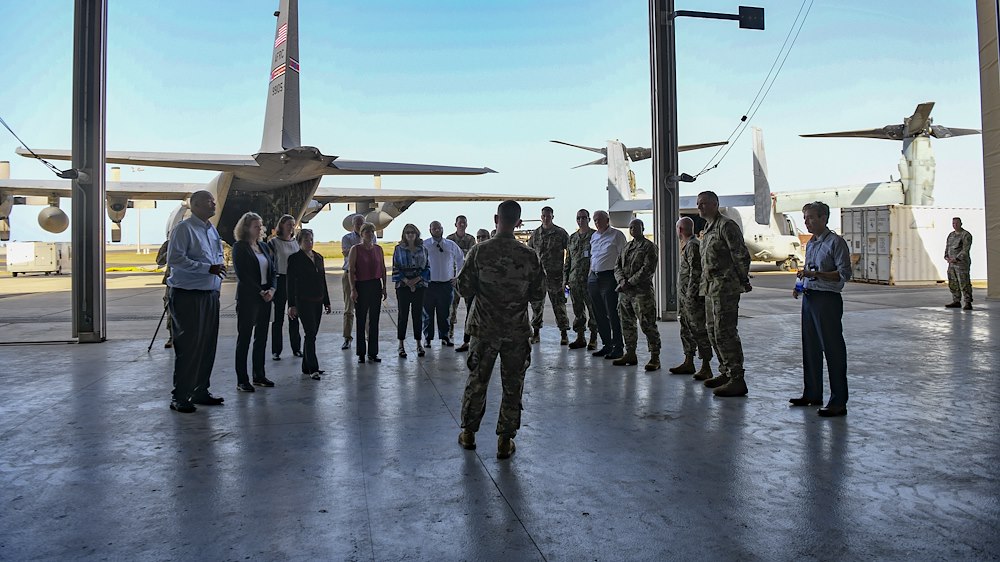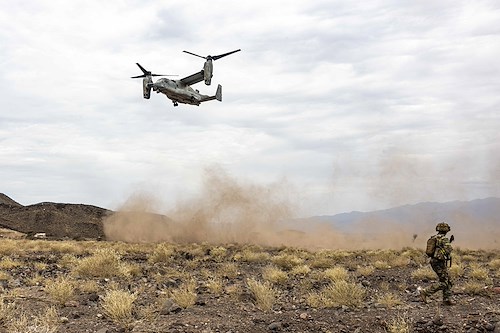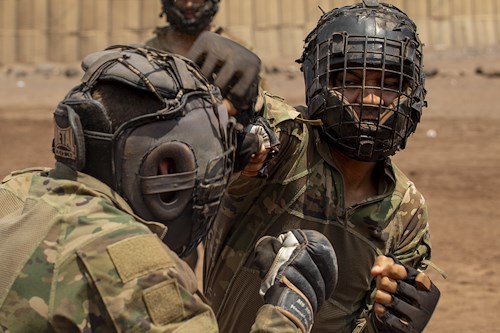Gallery contains 9 images
×
Photo 1 of 9
Combined Joint Task Force - Horn
U.S. Army Col. Timothy Macdonald, Combined Joint Task Force – Horn of Africa (CJTF-HOA) director of operations, provides a mission brief for Department of Defense and Department of State officials during the annual East Africa Security Forum (EASF) at Camp Lemonnier, Djibouti, May 11, 2022. More than 50 US government interagency officials working in more than 10 countries throughout East Africa attended the EASF. During the forum, representatives with the U.S. DoS, DoD, the US Agency for International Development (USAID), and the National Security Council discussed topics ranging from overarching long-term strategy to specific security threats in the region. (U.S. Air Force photo by Senior Airman Blake Wiles)
Photo by: Senior Airman Blake Wiles
Photo 2 of 9
Combined Joint Task Force - Horn
U.S. Army Col. Timothy Macdonald, Combined Joint Task Force – Horn of Africa (CJTF-HOA) director of operations, provides a mission brief for Department of Defense and Department of State officials during the annual East Africa Security Forum (EASF) at Camp Lemonnier, Djibouti, May 11, 2022. More than 50 US government interagency officials working in more than 10 countries throughout East Africa attended the EASF. During the forum, representatives with the U.S. DoS, DoD, the US Agency for International Development (USAID), and the National Security Council discussed topics ranging from overarching long-term strategy to specific security threats in the region. (U.S. Air Force photo by Senior Airman Blake Wiles)
Photo by: Senior Airman Blake Wiles
Photo 3 of 9
Combined Joint Task Force - Horn
U.S. Army Maj. Gen. Jami Shawley, incoming commanding general of Combined Joint Task Force - Horn of Africa (CJTF-HOA), and U.S. Army Brig. Gen. Stephen Case, deputy commanding general of CJTF-HOA, listen to a mission brief during the 2022 East Africa Security Forum (EASF) at Camp Lemonnier, Djibouti, May 11, 2022. More than 50 US government interagency officials working in more than 10 countries throughout East Africa attended the EASF. During the forum, representatives with the U.S. State Department, Department of Defense, the US Agency for International Development (USAID), and the National Security Council discussed topics ranging from overarching long-term strategy to specific security threats in the region. (U.S. Air Force photo by Senior Airman Blake Wiles)
Photo by: Senior Airman Blake Wiles
Photo 4 of 9
Combined Joint Task Force - Horn
U.S. Army Maj. Gen. William Zana, commanding general of Combined Joint Task Force - Horn of Africa (CJTF-HOA), welcomes Department of Defense and Department of State officials during the annual East Africa Security Forum (EASF) at Camp Lemonnier, Djibouti, May 11, 2022. More than 50 US government interagency officials working in more than 10 countries throughout East Africa attended the EASF. During the forum, representatives with the U.S. DoS, DoD, the US Agency for International Development (USAID), and the National Security Council discussed topics ranging from overarching long-term strategy to specific security threats in the region. (U.S. Air Force photo by Senior Airman Blake Wiles)
Photo by: Senior Airman Blake Wiles
Photo 5 of 9
Combined Joint Task Force - Horn
Ms. Chidi Blyden, deputy assistant secretary of defense for African affairs, briefs Department of Defense and Department of State officials during the annual East Africa Security Forum (EASF) at Camp Lemonnier, Djibouti, May 11, 2022. More than 50 US government interagency officials working in more than 10 countries throughout East Africa attended the EASF. During the forum, representatives with the U.S. DoS, DoD, the US Agency for International Development (USAID), and the National Security Council discussed topics ranging from overarching long-term strategy to specific security threats in the region. (U.S. Air Force photo by Senior Airman Blake Wiles)
Photo by: Senior Airman Blake Wiles
Photo 6 of 9
Combined Joint Task Force - Horn
U.S. Army Col. Timothy Macdonald, Combined Joint Task Force – Horn of Africa (CJTF-HOA) director of operations, provides a mission brief for Department of Defense and Department of State officials during the annual East Africa Security Forum (EASF) at Camp Lemonnier, Djibouti, May 11, 2022. More than 50 US government interagency officials working in more than 10 countries throughout East Africa attended the EASF. During the forum, representatives with the U.S. DoS, DoD, the US Agency for International Development (USAID), and the National Security Council discussed topics ranging from overarching long-term strategy to specific security threats in the region. (U.S. Air Force photo by Senior Airman Blake Wiles)
Photo by: Senior Airman Blake Wiles
Photo 7 of 9
Combined Joint Task Force - Horn
U.S. Air Force Maj. Gen. Kenneth P. Ekman, U.S. Africa Command strategy, engagement and programs director, briefs Department of Defense and Department of State officials during the annual East Africa Security Forum (EASF) at Camp Lemonnier, Djibouti, May 11, 2022. More than 50 US government interagency officials working in more than 10 countries throughout East Africa attended the EASF. During the forum, representatives with the U.S. DoS, DoD, the US Agency for International Development (USAID), and the National Security Council discussed topics ranging from overarching long-term strategy to specific security threats in the region. (U.S. Air Force photo by Senior Airman Blake Wiles)
Photo by: Senior Airman Blake Wiles
Photo 8 of 9
Combined Joint Task Force - Horn
Service members with the Combined Joint Task Force – Horn of Africa (CJTF-HOA) welcome interagency officials during the 2022 East Africa Security Forum (EASF) at Camp Lemonnier, Djibouti, May 11, 2022. More than 50 US government interagency officials working in more than 10 countries throughout East Africa attended the EASF. During the forum, representatives with the U.S. DoS, DoD, the US Agency for International Development (USAID), and the National Security Council discussed topics ranging from overarching long-term strategy to specific security threats in the region. (U.S. Air Force photo by Senior Airman Blake Wiles)
Photo by: Senior Airman Blake Wiles
Photo 9 of 9
Combined Joint Task Force - Horn
U.S. Brig. Gen. Stephen Case, deputy commanding general of Combined Joint Task Force – Horn of Africa (CJTF-HOA), speaks with Department of State officials during the 2022 East Africa Security Forum (EASF) at Camp Lemonnier, Djibouti, May 11, 2022. More than 50 US government interagency officials working in more than 10 countries throughout East Africa attended the EASF. During the forum, representatives with the U.S. DoS, Department of Defense, the US Agency for International Development (USAID), and the National Security Council discussed topics ranging from overarching long-term strategy to specific security threats in the region. (U.S. Air Force photo by Senior Airman Blake Wiles)
Photo by: Senior Airman Blake Wiles
CAMP LEMONNIER, Djibouti – More than 50 US government interagency officials working in more than 10 countries throughout East Africa met together here for the 2022 East Africa Security Forum May 11, 2022.
Maj. Gen. William L. Zana, commander of Combined Joint Task Force – Horn of Africa (CJTF –HOA), hosted the forum, which provided a face-to-face platform for representatives with the U.S. State Department, Department of Defense, the US Agency for International Development (USAID), and the National Security Council. The discussions ranged from overarching long-term strategy to specific security threats in the region.
"Africa is home to a complex security environment - ripe with opportunity and challenges alike. This is especially true in East Africa,” said U.S. Army Gen. Stephen J. Townsend, commander of US Africa Command (AFRICOM). “Al Shabaab, the largest, wealthiest and most lethal Al Qaeda affiliate in the world, continues violent attacks like the one in Ceel-Baraf last week. Left unchecked, violent extremists and other security challenges will continue to put East Africa at increasing risk. These challenges, including democratic backsliding, conflict, drought and famine, are exactly why the East Africa Security Forum exists.
“I look forward to the progress that will result from this forum and how we can all work together to promote a more secure and stable region," Townsend added.
In addition to policy, strategy, and security, the participants were also introduced to other ways U.S. assets could be benefit East Africa.
“I am pleased to be here at the U.S. military base in Djibouti to focus our attention on one of our most important goals—working with our African partners on regional peace, security and prosperity,” Peter Lord, the Deputy Assistant Secretary for East Africa, Sudan, and South Sudan for the U.S. State Department, said about the forum. “We appreciate CJTF-HOA creating this opportunity for colleagues from the State Department, USAID and the Department of Defense to discuss issues related to security and stability in East Africa. Close coordination is vital as we work with our regional partners to address threats to peace, stability and development in the region.”
Discussions on the danger of food scarcity due to the ongoing unprecedented drought across the region, humanitarian relief planning for East Africa, led to conversations on the negative impact of Russia’s unprovoked, unjustified war against Ukraine.
“The opportunity to come together and discuss our shared concerns in East Africa is essential,” said Zana, “In addition to security discussions, we also address the use of military capabilities for potential humanitarian assistance requirements throughout the region.”
The open forum consisted of four sessions throughout the day and was an excellent source of information sharing and coordinating between all of the U.S. organizations working in the region. A demonstration of CJTF-HOA’s East Africa Response Force (EARF) was also part of the day’s event, informing the participants of the response force capabilities to support U.S. interests in East Africa.
“Everything we do to support our African partners is aligned with our Department of Defense and Department of State colleagues in the region; the East African Security Forum is an example of how we effectively coordinate our support,” said Zana. “Our relationships are based on shared values and interests in East African security.”
DoD’s no-fail mission in Africa
The DoD, through CJTF-HOA, has a no-fail mission accomplished by its EARF: crisis response, security augmentation and assisted departure for threats posed toward U.S. interests in East Africa, and the greater continent.
Conceptually, the idea is simple. Have a readied, non-combative force that can respond quickly across the tyranny of distance in Africa to protect coalition and American lives. Operationally, the concept is more complex.
Ensuring a readied response force requires constant attention and practice, which takes form in periodic Emergency Deployment Readiness Exercises (EDRE). Each EDRE is planned for months but executed in moments. The reoccurring response planning and completion allows the team practice, so they can act quickly and efficiently when called upon. Logistics, support and transportation also play a major role in each exercise; each are coordinated amongst the team at CJTF-HOA and supporting units at Camp Lemonnier, Djibouti.
The exercises create opportunities for CJTF-HOA staff and leadership to link with U.S. Embassies and assets on the ground, building standardized and familiar security practices.
“These EDREs are integral to creating opportunities for integrated joint, multinational training and in keeping our fellow U.S. partners and members safe and comfortable knowing we are always here,” said Col. Tim MacDonald, CJTF-HOA director of operations. “These exercises are regularly scheduled and reflect potential, real-world scenarios that offer realistic training that allows us to more effectively prepare for crisis response.”
The exercises represent actualized abilities to reassure the DoS and partners that the DoD can rapidly respond to threats, enabling U.S. embassies to continue operations in challenging security environments. Instability and security concerns exist throughout the globe; it is no different for East Africa where the threat of violent extremist organizations persists.
The EARF is the primary security asset fulfilling CJTF-HOA’s crisis response mission and is currently comprised of Virginia Army National Guard Soldiers from A Company, 3rd Battalion, 116th Infantry Regiment. In their Task attached to Task Force Red Dragon. Under operational command of CJTF-HOA, TFRD is comprised of Soldiers with the Virginia Army National Guard, Tennessee Army National Guard, and Kentucky National Guard. Transport of the EARF is supported by Marine and Air Force air components: currently the Marine Medium Tiltrotor Squadron 163 (VMM-163) with MV-22 Osrey or the 75th Air Expeditionary Squadron with C-130J Super Hercules.
In addition to the no-fail mission to support DoS, the EARF is postured to respond to a broad range of military operations including support for non-combatant evacuation operations, humanitarian assistance, disaster relief operations, recovery of aircraft and personnel, support to U.S. embassies and other missions as directed.
As with any high-stakes responsibilities, practice is key; although, the exercises also offer opportunities for forming and improving relationships with players who would be involved in direct emergency responses.
“What makes our EDRE exercises so beneficial is that for the majority of them we are working alongside our partners in the region and at the actual DoS facilities that we may be called upon to support,” said MacDonald. “Learning how each partner operates is priceless for the EARF and our ability to respond to situations in the region."
In 2022, CJTF-HOA completed four EDREs focusing on US Embassies in South Sudan, Kenya, and Somalia, respectively. At each location, the EARF becomes familiar with the environments, facilities, and routes to solidify response plans in case of a crisis. The response team also practices Embassy and security team tactics, techniques and procedures at each location.
Each EDRE serves to reinforce the U.S. partnership with host countries and to validate the EARF’s capabilities to execute their mission across the Horn of Africa.
































